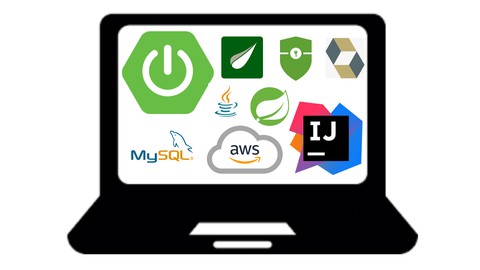
Spring Boot 3 Thymeleaf REAL-TIME Web Application – Blog App
Spring Boot 3 Thymeleaf REAL-TIME Web Application – Blog App, available at $79.99, has an average rating of 4.51, with 119 lectures, 1 quizzes, based on 232 reviews, and has 1355 subscribers.
You will learn about Learn to Build a Web Application Using a Real-Time Industry Standard Approach Using Spring Boot 3 and Thymeleaf. Learn to Build a Complete Blog Full-Stack Web Application – Spring Boot MVC as Backend and Thymeleaf as Frontend Learn How Spring Mvc Works and How to Use Spring Mvc to Build a Web Application Learn How to Use Thymeleaf Attributes, Layouts, Form Handling, Standard Expressions, Etc Learn Form and Bean Validations Using Hibernate Validator Learn How to Use Bootstrap CSS 5 Framework for Styling Web Pages. Learn JPA One to Many and Many to One Mappings Learn How to Connect Spring Boot Application With MySQL Database Learn How to Use Three-Layer Architecture – Controller, Service, and Repository/Dao Layers. Learn How to Create JPA Entities for a Blog Application Learn How to Create Spring Data JPA Repositories for JPA Entities Learn How to Secure Web Applications Using Spring Security Learn How to Use Spring Security’s Authentication and Authorization Learn How to Implement Registration, Login and Logout Features Learn to implement Filter/Search Feature Learn to Create a Custom Mapper to Convert Entity to DTO and Vice Versa Learn How to Deploy Spring Boot MVC Web Application to AWS Cloud This course is ideal for individuals who are This course is for someone who want to learn how to develop a real-time web application using Spring boot and Thymeleaf or If you have requirement to develop a Spring MVC web application in your company/organization then you can take this course for your reference. It is particularly useful for This course is for someone who want to learn how to develop a real-time web application using Spring boot and Thymeleaf or If you have requirement to develop a Spring MVC web application in your company/organization then you can take this course for your reference.
Enroll now: Spring Boot 3 Thymeleaf REAL-TIME Web Application – Blog App
Summary
Title: Spring Boot 3 Thymeleaf REAL-TIME Web Application – Blog App
Price: $79.99
Average Rating: 4.51
Number of Lectures: 119
Number of Quizzes: 1
Number of Published Lectures: 114
Number of Published Quizzes: 1
Number of Curriculum Items: 120
Number of Published Curriculum Objects: 115
Original Price: $29.99
Quality Status: approved
Status: Live
What You Will Learn
- Learn to Build a Web Application Using a Real-Time Industry Standard Approach Using Spring Boot 3 and Thymeleaf.
- Learn to Build a Complete Blog Full-Stack Web Application – Spring Boot MVC as Backend and Thymeleaf as Frontend
- Learn How Spring Mvc Works and How to Use Spring Mvc to Build a Web Application
- Learn How to Use Thymeleaf Attributes, Layouts, Form Handling, Standard Expressions, Etc
- Learn Form and Bean Validations Using Hibernate Validator
- Learn How to Use Bootstrap CSS 5 Framework for Styling Web Pages.
- Learn JPA One to Many and Many to One Mappings
- Learn How to Connect Spring Boot Application With MySQL Database
- Learn How to Use Three-Layer Architecture – Controller, Service, and Repository/Dao Layers.
- Learn How to Create JPA Entities for a Blog Application
- Learn How to Create Spring Data JPA Repositories for JPA Entities
- Learn How to Secure Web Applications Using Spring Security
- Learn How to Use Spring Security’s Authentication and Authorization
- Learn How to Implement Registration, Login and Logout Features
- Learn to implement Filter/Search Feature
- Learn to Create a Custom Mapper to Convert Entity to DTO and Vice Versa
- Learn How to Deploy Spring Boot MVC Web Application to AWS Cloud
Who Should Attend
- This course is for someone who want to learn how to develop a real-time web application using Spring boot and Thymeleaf
- If you have requirement to develop a Spring MVC web application in your company/organization then you can take this course for your reference.
Target Audiences
- This course is for someone who want to learn how to develop a real-time web application using Spring boot and Thymeleaf
- If you have requirement to develop a Spring MVC web application in your company/organization then you can take this course for your reference.
In this course, you will learn how to build a real-time complete blog application step by step using Spring Boot 3, Spring MVC, Thymeleaf, Spring Security 6, Spring Data JPA, and MySQL database.
In this course, we will be using Spring Boot 3, Spring Framework 6, Spring Security 6 (no deprecated APIs/classes), and Thymeleaf 3 – The latest versions as of now.
I have added a Thymeleaf crash course with 20+ lectures so if you are new to Thymeleaf then first watch the Thymeleaf crash course and then build a Blog application.
Note: This is the project development course so you need to have a basic understanding of Spring Boot, Spring Security, Spring Data JPA, and MySQL database
What you will learn?
– Learn to build a web application using a real-time industry standard approach using Spring boot 3 and Thymeleaf.
– Learn to build a complete blog full-stack web application – Spring Boot MVC for backend and Thymeleaf for Frontend.
– Learn how to use Spring MVC to build a web application
– Learn how to use Thymeleaf attributes, layouts, form handling, standard expressions, etc
– Learn Form and Bean Validations using Hibernate Validator
– Learn how to use Bootstrap CSS 5 Framework for styling web pages.
– Learn how to connect Spring boot application with MySQL database
– Learn how to use three-layer architecture – controller, service, and repository/DAO layers.
– Learn how to create JPA entities for a Blog application
– Learn how to create Spring Data JPA repositories for JPA Entities
– Learn how to secure Web applications using Spring Security
– Learn how to use Spring Security’s Authentication and Authorization
– Learn how to implement Registration, Login, and Logout features
– Learn to implement Filter/Search Feature
– Learn to create a custom Mapper to convert Entity to DTO and vice versa
What is Spring Boot?
Spring Boot is basically an extension of the Spring framework which eliminated the boilerplate configurations required for setting up a Spring application.
Spring Boot is an opinionated framework that helps developers build Spring-based applications quickly and easily. The main goal of Spring Boot is to quickly create Spring-based applications without requiring developers to write the same boilerplate configuration again and again.
What is Thymeleaf?
Thymeleaf is a modern server-side Java template engine for both web and standalone environments, capable of processing HTML, XML, JavaScript, CSS, and even plain text.
The main goal of Thymeleaf is to provide an elegant and highly-maintainable way of creating templates.
It’s commonly used to generate HTML views for web applications.
Thymeleaf is a very popular choice for building UI so we will be using Thymeleaf to build the view layer in the Spring MVC web application (Blog App).
Technologies and Tools Used:
– Java 17
– Spring Boot 3
– Spring Framework 6
– Spring MVC 6
– Thymeleaf
– Bootstrap CSS 5 Framework
– Spring Security 6
– Spring Data JPA
– Hibernate Framework 6
– MySQL Database
– Maven
– IntelliJ IDEA
– AWS
Sample amazing feedback from students on this course:
Dhirendra Singh:
“Ramesh is always a NICE teacher……..”
Stefan Petkov:
“Very well structured course. Understandable and well explained the basic concepts in Spring Framework and Thymeleaf. Good job Ramesh!”
Tuan Anh Do:
“Great course, the instructor is also enthusiastic to answer, some practical problems have been solved in the lesson”
Adnan Alasow:
“The instructor effectively communicates in a clear and simplified manner that enables a beginner such as myself to comprehend the material.”
Devin Berkani:
“Ramesh is simply the best instructor around when it comes to all things Java and Spring. The course was structured in such a way that I was able to complete a full-fledged CRUD application by the end of it and actually understand WHY it works as opposed to just mindlessly typing code alongside someone in a video (which was unfortunately my experience with many other Udemy courses before I found Ramesh). I feel more confident and comfortable with Spring Boot than I ever thought I could after such a short amount of time. One of the things that impressed me the most was how quick Ramesh was with his responses. Whenever I had a question, he was there to answer it in a timely manner. I felt like I was his only student, even though there were probably hundreds of others in the class. I am so grateful for Ramesh’s expertise and can’t wait to start his REST API course next! This course deserves more than a 5-star rating, but that’s all I can give, so that’s what it gets.”
FRANCISCO ERICK CARMONA GARCIA:
“This course teaches you all related to Thymelead plus Spring boot security, how to create project well structured, practical CSS Bootstrap, Relational Database, JPA. Explanation is clear from the instructor.”
Check out all the reviews/ratings for this course in the Reviews section of this course.
Course Curriculum
Chapter 1: Introduction
Lecture 1: Course Introduction – What We'll Build In This Course
Lecture 2: Understanding Project High Level Requirements
Lecture 3: Download Source Code
Lecture 4: Download Class Notes in PDF
Chapter 2: Spring MVC Introduction
Lecture 1: What is Spring MVC?
Lecture 2: What is DispatcherServlet?
Lecture 3: Spring MVC Components
Lecture 4: How Spring MVC Works Internally
Lecture 5: Spring Boot Web MVC Architecture (Three – Layer Architecture)
Chapter 3: Learn Thymeleaf Fundamentals
Lecture 1: What is Thymeleaf?
Lecture 2: How Thymeleaf Engine Work?
Lecture 3: Create Spring Boot Project and Integrate Thymeleaf
Lecture 4: Spring Boot Auto Configuration for Thymeleaf
Lecture 5: Thymeleaf Spring Boot Hello World Example
Lecture 6: Thymeleaf Variable Expressions
Lecture 7: Thymeleaf Selection Expressions
Lecture 8: Thymeleaf Message Expressions
Lecture 9: Thymeleaf Link (URL) Expressions
Lecture 10: Thymeleaf Fragment Expressions
Lecture 11: Thymeleaf Attribute – th:text
Lecture 12: Thymeleaf Looping or Iteration – th:each Attribute
Lecture 13: Thymeleaf Looping or Iteration – th:each Attribute Status Variable
Lecture 14: Thymeleaf Attribute – th:if and th:unless
Lecture 15: Thymeleaf Attribute – th:switch and th:case
Lecture 16: Form Handling in Thymeleaf – Overview
Lecture 17: Form Handling in Thymeleaf – Create Handler Method to Return Register Page
Lecture 18: Form Handling in Thymeleaf – Design User Registration Form
Lecture 19: Form Handling in Thymeleaf – Display User Registration Form Data
Chapter 4: Create and Setup Spring Boot Blog Project
Lecture 1: Create and Setup Spring Boot Project in IntelliJ
Lecture 2: Understanding spring-boot-starter-thymeleaf Dependency
Lecture 3: Configure MySQL Database in Spring Boot App
Lecture 4: Create Standard Packaging Structure
Lecture 5: Create Post JPA Entity
Lecture 6: Create PostRepository Interface
Lecture 7: Create PostDto
Lecture 8: Create PostMapper
Lecture 9: Download Source Code of this Section
Chapter 5: Implement List Posts Feature [ADMIN]
Lecture 1: Implement List Posts Feature – Overview
Lecture 2: Create Service Layer for List Posts Feature
Lecture 3: Create Controller Layer for List Posts Feature
Lecture 4: Create Thymeleaf Template to Display List of Posts
Lecture 5: Add Header and Footer to Thymeleaf Template HTML Page
Lecture 6: Include Header, Navbar, and Footer as Fragments
Lecture 7: Download Source Code of this Section
Chapter 6: Implement Create Post Feature [ADMIN]
Lecture 1: Implement Create Post Feature – Overview
Lecture 2: Create Handler Method to Handle Create Post Request
Lecture 3: Create Post Form Handling
Lecture 4: Create Handler Method to Save Post
Lecture 5: Adding Validation to Create Post Form
Lecture 6: Adding jQuery CKEditor to Crete Post Form
Lecture 7: Download Source Code of this Section
Chapter 7: Implement Update Post Feature [ADMIN]
Lecture 1: Implement Update Post Feature -Overview
Lecture 2: Create Handler Method for Edit Post Request
Lecture 3: Create Thymeleaf Template for Edit Post
Lecture 4: Create Handler Method to Update Edited Post Data
Lecture 5: Download Source Code of this Section
Chapter 8: Implement Delete Post Feature [ADMIN]
Lecture 1: Implement Delete Post Feature Step by Step
Lecture 2: Download Source Code of this Section
Chapter 9: Implement View Post Feature [ADMIN]
Lecture 1: Implement View Post Feature – Overview
Lecture 2: Create Handler Method to Handle View Post Request
Lecture 3: Create Thymeleaf Template for View Post
Lecture 4: Download Source Code of this Section
Chapter 10: Implement Blog Search Posts Feature [ADMIN]
Lecture 1: Search Blog Posts Feature Overview
Lecture 2: Implement Backend for Search Blog Posts Feature
Lecture 3: Implement Frontend for Search Blog Post Feature
Lecture 4: Quickly Refactor UI Code
Lecture 5: Download Source Code of this Section
Chapter 11: Blog Client Side Implementation [CLIENT]
Lecture 1: Display List of Blog Posts Backend Implementation
Lecture 2: Display List of Blog Posts Frontend Implementation
Lecture 3: View Blog Post Implementation
Lecture 4: Blog Search Feature Backend Implementation
Lecture 5: Blog Search Feature Frontend Implementation
Lecture 6: Download Source Code of this Section
Chapter 12: Blog Comments Management [CLIENT]
Lecture 1: Blog Comments Management – Section Introduction
Lecture 2: Create Comment JPA Entity
Lecture 3: Create CommentRepository
Lecture 4: Create CommentDto
Lecture 5: Create CommentMapper
Lecture 6: Create Comment Form Handling
Lecture 7: Create Handler Method to Save Comment
Lecture 8: Adding Validation to Create Comment Form
Lecture 9: Display List of Comments for Blog Post
Chapter 13: Admin Side Comments Management [ADMIN]
Lecture 1: List Comments Feature – Backend
Lecture 2: List Comments Feature – Frontend
Lecture 3: Add Delete Comment Feature
Chapter 14: SignUp/Register to Blog App [GUEST USER]
Lecture 1: Registration Feature – Section Introduction
Instructors
-
Ramesh Fadatare (Java Guides)
Software Engineer, Spring Certified, YouTuber and Instructor
Rating Distribution
- 1 stars: 1 votes
- 2 stars: 0 votes
- 3 stars: 19 votes
- 4 stars: 75 votes
- 5 stars: 137 votes
Frequently Asked Questions
How long do I have access to the course materials?
You can view and review the lecture materials indefinitely, like an on-demand channel.
Can I take my courses with me wherever I go?
Definitely! If you have an internet connection, courses on Udemy are available on any device at any time. If you don’t have an internet connection, some instructors also let their students download course lectures. That’s up to the instructor though, so make sure you get on their good side!
You may also like
- Best Investing Courses to Learn in March 2025
- Best Personal Finance Courses to Learn in March 2025
- Best Health And Wellness Courses to Learn in March 2025
- Best Chatgpt And Ai Tools Courses to Learn in March 2025
- Best Virtual Reality Courses to Learn in March 2025
- Best Augmented Reality Courses to Learn in March 2025
- Best Blockchain Development Courses to Learn in March 2025
- Best Unity Game Development Courses to Learn in March 2025
- Best Artificial Intelligence Courses to Learn in March 2025
- Best Flutter Development Courses to Learn in March 2025
- Best Docker Kubernetes Courses to Learn in March 2025
- Best Business Analytics Courses to Learn in March 2025
- Best Excel Vba Courses to Learn in March 2025
- Best Devops Courses to Learn in March 2025
- Best Angular Courses to Learn in March 2025
- Best Node Js Development Courses to Learn in March 2025
- Best React Js Courses to Learn in March 2025
- Best Cyber Security Courses to Learn in March 2025
- Best Machine Learning Courses to Learn in March 2025
- Best Ethical Hacking Courses to Learn in March 2025






















